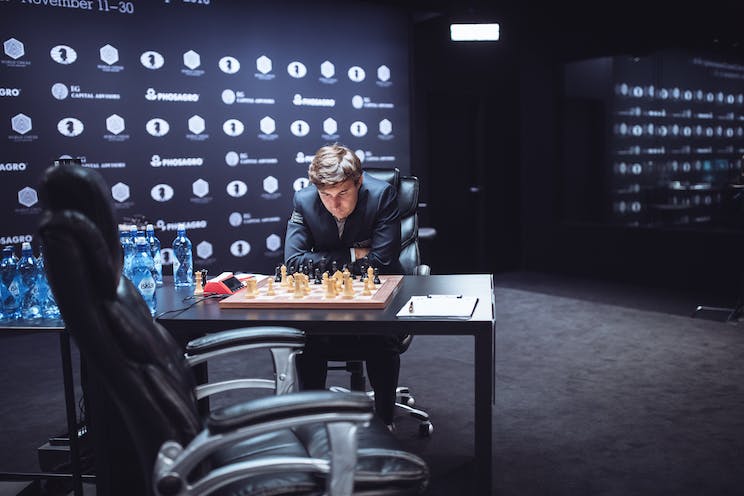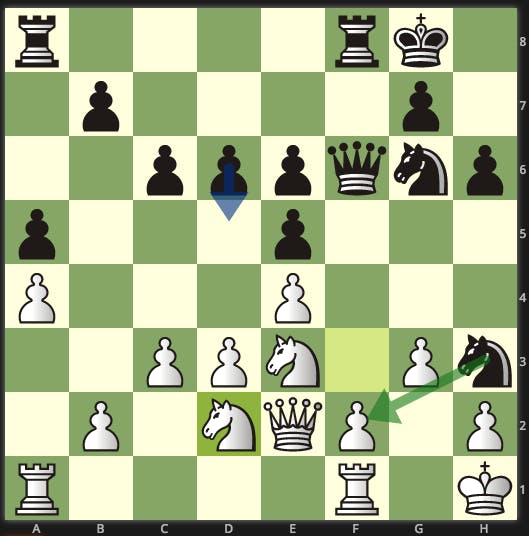2016 WCC, Game 10: The Beautiful Struggle
Carlsen needs a win badly

How did Carlsen and Karjakin get here?
Trying to predict how Carlsen will handle this must-win situation is difficult because he’s never been in this situation before. Carlsen never trailed in either World Championship Match with Anand, and this is Karjakin’s first World Championship match, so it’s difficult to say how the pressure, and high steaks are affecting him.
What we can look at is how the players got here: the Candidates Tournament. Carlsen’s journey to the World Chess Championship was odd. In the 2013 Candidates Tournament Carlsen was tied with Vladimir Kramnik going into the last round, but Carlsen had better tie-breaks. It was a “win and in” for Carlsen. It was a “must outscore Carlsen” for Kramnik. Carlsen got into time trouble in his game against Svidler, misjudged Svidler’s attack, and lost. Fortunately for Carlsen, Ivanchuk was also outplaying Kramnik. Both Carlsen and Kramnik resigned within minutes of each other, and Carlsen limped into the World Championship.
In the last round of the 2016 Candidates Tournament, Karjakin and Fabiano Caruana were tied neck and neck. Karjakin had better tie-breaks, so Caruana was in the must-win situation. It also just so happened that Karjakin and Caruana were playing each other in the final round. We discussed this game in the lichess preview article, where Karjakin’s strategy was to let Caruana desperately attack him. Karjakin ended the game with a devastating rook sacrifice that took advantage of Caruana’s lack of king safety. Karjakin kicked in the door to the World Championship and said something really cool like, “I’m here to play chess and drink vodka, and I’m all out of vodka.”
Each player’s last game of their respective Candidates Tournament found them in similar position to their pre-game-10 situation. Carlsen fell into time trouble and lost. Karjakin used his opponent's desperation against them and won when he didn’t need to.
Game 10
https://lichess.org/study/vENPCM25/CtnXiIkN
Carlsen didn't change his modest opening strategy for Game 10. Carlsen chose the Ruy Lopez with 4.d3, responding to Karjakin’s 3...Nf6. The opening move that had that special 'Magnus Touch' was 6.Bg5 diverging from 6.0-0 which is 15 times more popular. Carlsen completely departed from anything seen in the lichess opening explorer by move 10. If you’re just joining the match, this is what Carlsen wants from the opening: a fresh position where he’s equal and can hopefully outplay his opponent. This strategy got Carlsen as close to a win as you can get in Game 3, Karjakin played perhaps the best defense of his life to save the draw.

Karjakin, staunch defender-- Courtesy of World Chess
The Weirdest Moment of The Match
Imagine you’re in the backseat of a car with two people up front. The driver absolutely hates apples, while the passenger loves apples more than anything on earth. You are really confused when you see the driver take a right on a road where there is a huge sign reading “Apple Orchard.” He hates apples, why did he take this turn? Then you see the apple orchard in the distance. Is the passenger going to injure himself jumping from the window of a moving car? Will he demand the driver pull over? What’s going to happen? Your surprise continues as the car drives right by the orchard without either person saying a word.
This is how spectators felt watching both players make their 20th move.

Carlsen is the driver, Karjakin is the passenger, and apples are draws. Carlsen plays 20.Nd2 giving Karjakin 20...Nxf2+ with many chances for a perpetual check. The most clear follow up would be 21.Kg2 Nh4+. Carlsen would then have the choice of moving his King to 22.g1, allowing 22...Nh3+ with a perpetual check or 22.gxh4 Qg6+ with the advantage to Karjakin. Instead, Karjakin played d5 ignoring the drawing chances that 20...Nxf2 gives.
Fatigue is setting in for both players. Carlsen said he thought the game was going to be over after he played 20.Nd2. Karjakin confessed he didn’t see the drawing and/or winning line after Nh4+. After 25...Rf7 all the dust had settled from the 'apple orchard incident.' Both players had two rooks, a knight, all their pawns, two doubled pawns for Karjakin, and their kings. But Karjakin’s position has a lot of targets for Carlsen to hone in on.

The most annoying square of the match for Carlsen is…
f4. Games 1 and 4 featured Carlsen pushing protected pawns to f4. In Game 1 Carlsen made the move with a white pawn. In Game 4 he made it with a black pawn. Both moves were criticized for the same reason: f4 simplified the position and made Karjakin’s defense easier by giving him less opportunities to make mistakes.
I had this fact in my back pocket and intended to keep it there as it’s ultimately arbitrary. But it’s too relevant to Game 10 not to share it, look at Carlsen’s 51st move.

f4 would totally spoil this position for white. It would cut off the rooks course of d4,f4,f6 giving Karjakin one less threat to worry about. Carlsen played f3, putting the pawn on a square where it’s protected by the a3 rook, it says no, no, no to the knight on h6, and keeps the rooks line of attack open on the kingside.
Would Carlsen actually win?
The long-suffering and brutal positional nature of these games is so unbelievably subjective. Yes, Carlsen had an edge just like in Games 3 and 4. When the games are happening I am a chess agnostic. Carlsen had approximately a 2 pawn edge, and World Chess had him at 75% to win. My heart stopped beating when Carlsen made his 62nd move.

62. Rxg6 was recommended, and after the rook exchange at d3, Carlsen’s lead grows. Kingscrusher shows us in his analysis above, the problem with Nd5 is white will eventually have to trade his e-pawn for black’s d-pawn. In the Rxg6 line, white is able to hold his e-pawn while still securing black’s d-pawn. The players were entering their 6th hour of play.
How did it end?
On the 72nd move of Game 10, Magnus Carlsen activated his final piece, his king. 72.Kf3 began a king march that would leave Karjakin’s rook no safe squares on the h-file. Carlsen’s last 4 moves were king moves, ending on f6. Karjakin has no magical drawing plans this time and he resigned on move 75.

After the game Karjakin gave interviews, he arrived at the press conference early and he waited for Carlsen. He answered questions and follow-up questions as well. Karjakin is a class act. How did Karjakin look? I would say he had a 1,000 yard stare, typically seen on someone who has spent too much time at war.
Carlsen looked like the Carlsen we’re all used to.

So Karjakin can be beat -- Photo Courtesy of World Chess
Two more games in regulation!
About the Author:
Tyler Schwartz is a passionate chess ambassador. Tyler is the President of Chess at 3, teaching chess to children all over the world at the suprising age of 3. He is the Head of Media at lichess.org. Tyler also manages a chess club on the upper east side of Manhattan.